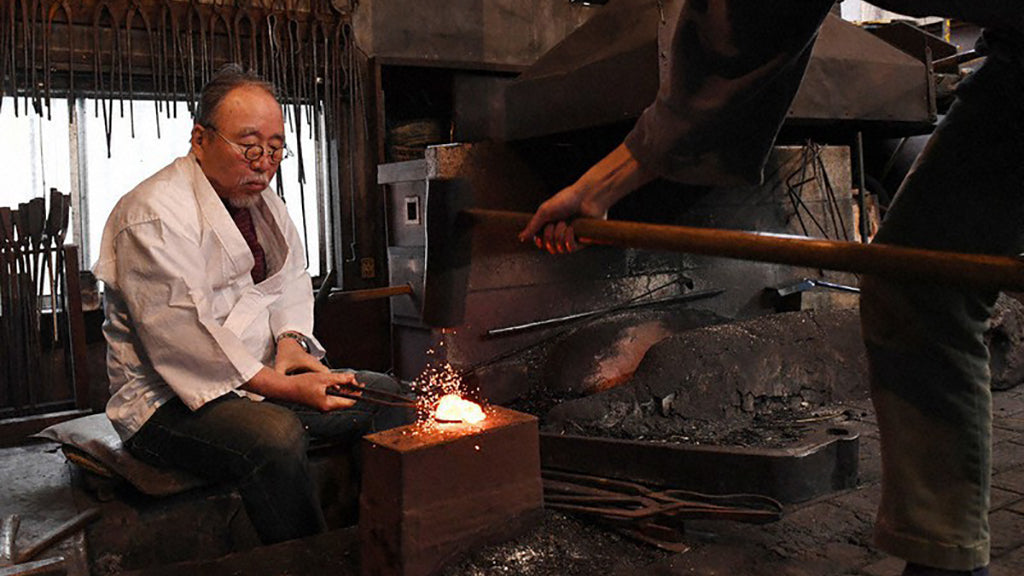Low Temperature Smelting and Forging Skills of Japanese Katana

Forging a Samurai Sword: The Art of Crafting Japan's Legendary Blade
The traditional low-temperature smelting and forging techniques of the Japanese katana involve carefully selecting iron sand to create high carbon steel with the ideal carbon content. Skilled swordsmiths forge the blade by combining multiple pieces of steel, gradually shaping it into the rough shape of a katana. During the process, different parts of the blade are refined, ensuring strength and flexibility. To enhance the cutting edge, a special method is used where clay is applied before quenching, creating the signature hamon pattern. Finally, meticulous grinding and polishing perfects the edge of the blade, making it razor-sharp and battle-ready.
How long does it take to forge a samurai sword?
Forging a traditional samurai sword can take anywhere from several weeks to a few months. The exact time depends on the complexity of the sword, the skill of the swordsmith, and the techniques used.
The process involves multiple stages:
- Forging the blade (which can take several days)
- Shaping and polishing the blade (another week or more)
- Applying clay to create the signature hamon
- Final polishing and sharpening, which can take weeks.
It’s a meticulous, labor-intensive process that requires a high level of craftsmanship.
Since the Han Dynasty, various technologies and goods in China have been continued to flow into Japan. With the more and more advanced iron and steel smelting technology and the introduction of sword making techniques, after a certain period of development, the sword manufacturing technology finally stabilized on the Japanese island nation and developed into a unique Japanese sword manufacturing system. Even now, it is not changed much from the Japanese sword manufacturing system five or six hundred years ago. Speaking of the Japanese sword manufacturing, we have to say that the raw materials of making Japanese swords, especially the legendary "Tahamagane", which must be explained clear. Only in this way can we further understand the unique features of Japanese swords.
1. Low temperature smelting technology of Japanese swords

The finished product refined through this low temperature smelting method is a kind of irregular porous cavernous block-shaped iron and steel, it is generally called "sponge iron", which is essentially the same product as the earliest block iron made in ancient China.
When smelting, Japanese smelters will put sand iron into the steel refining furnace, then add special charcoal, and start smelting. Because they use charcoal, rather than coal and coke, the temperature is limited, and the furnace temperature can't be greatly improved, which has a considerable and important effect on the purity of steel, the final shape of the material, the performance, as well as its final uses.

If subdivide the Tatara steel making process in Japan, it can be divided into two branches, one is Kura method, and the other is Zuku method. Kura is a method using sand iron as raw material, which is also found in private small smelting. For example, some areas will use a kind of sand iron called "Masa" as the main material, this kind of sand iron called "Masa" is produced in the "China" region of the western part of Japan, which contains less impurities such as manganese, phosphorus and so on than ordinary iron ore, so the steel made from it is relatively pure.
2. Forging skills of Japanese swords
In fact, Japan didn't begin to study that using the mass production of coal to smelt blast furnaces until the 16th century, and it was not until two centuries later, in 1873, that it formally completed the research and development of high-temperature reflected refined furnaces using coal. Therefore, there are a large part of Japanese swords in the Shinshintou period were made of high-temperature furnace products in the concept of metallurgical industry, while the traditional smelting methods were fading and almost disappearing. And therefore, Suishinshi Masahide launched the retro movement of the Japanese sword, and finally successfully retained the traditional low-temperature smelting and forging method until now, and basically fixed the concept that the traditional Japanese sword should use traditional smelting and forging skills.
It is worth noting that in the previous two periods, a considerable part of the raw materials used by the swordsmiths were foreign steel products, that is, the so-called "Ship-borne iron" in Japan, the varieties are mainly Chinese fried steel, irrigation steel products, and some Indian steel and Nanman iron and so on. Although the swordsmiths of the following two periods mainly used the local steel raw materials, these foreign steel products mentioned above have always been used by Japanese swordsmiths since the Jyoukotou period to the Shinshintou period, but the amount varies.

Although there are many disadvantages of sponge iron, which is a relatively primitive smelting product, it also has a special feature, that is, it can refine steel, pig iron and wrought iron at the same time. Because this kind of iron making product contains more impurities and has complicated components, and it is inconvenient to be used, it was gradually phased out. Due to the restrictions of fuel and some other reasons, Japanese sword makers had no choice but to make the best use of this characteristic, so they began to apply different ingredient materials on different parts of the cutting tools, meanwhile continuously improved the forging technology, thereby finding an almost the best way to use this kind of primitive blocks with complicated components for iron-making, which has been passed down to this day. Eventually it was even developed to the point where a knife would not be a traditional all black katana if it were not made of the raw materials obtained in this way.

The key point is that after menstrual heat treatment, products manufactured by low-temperature forging technology can have the variety of changes and beautiful subways and Tsubagaku that the Japanese strive to pursue. It can be said that the process from obtaining raw materials to forming Japanese all black katana is a kind of process that developing low temperature smelting and forging, thermal treatment technology to the fullest.
